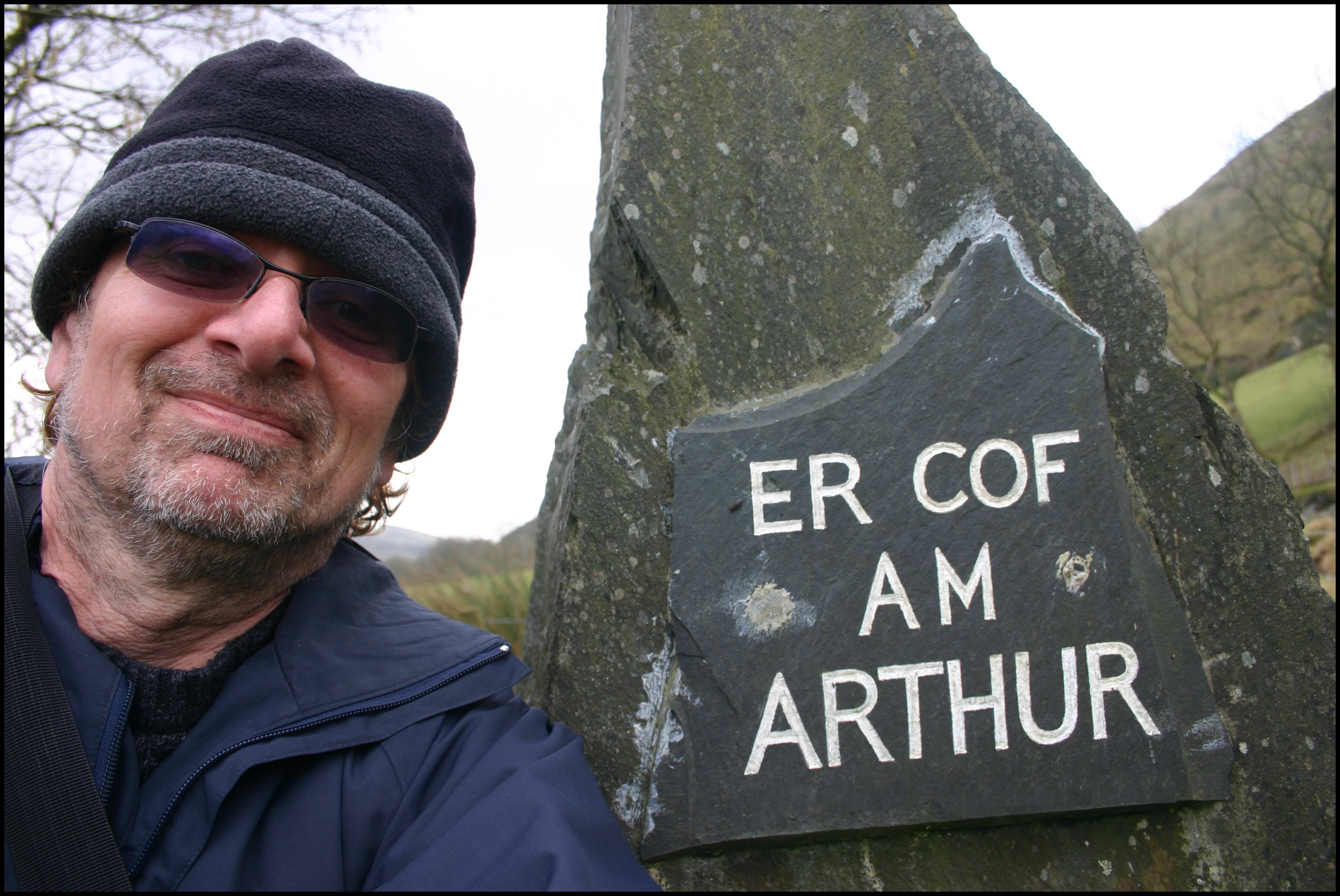

Forward from the author: This book represents ten years of research during the time I lived in my house overlooking Harlech Castle with visits to the actual Arthurian sites, taking photographs, researching in libraries, and even holding the jaw of St. Armel (Arthur)A5 in my hand! I have always been bothered by the Arthur myth that was built on mistakes and elaborated for entertainment. Clearly, Arthur was a real person and I was determined to write this book that would show Arthur's true story. The key to finding him was when I discovered that he lived from 482-562 and that he was age 55 at his defeat at Camlann in 537 but lived to the age of 80 in Brittany as a Saint.
The researchers spend their time digging in Tintagel Castle (built in the 1230s!) and search for clues from Geoffrey of Monmouth's fabricated story. Instead, I found Arthur documented in the Llandaff Charters as the King of Gwent in Wales, studying with the famous Celtic Christian Saints of Wales. Using genealogy I found his descent from Magnus Maximus and Constantine the Blessed, both Emperors of the Western Roman Empire, which made him well-suited to fight against the encroachments of the Saxons and Gewissei. I found many other details in the Anglo-Saxon ChroniclesASC aligned with Annales CambriaeAC, Nennius' (Historia Brittonum)NEN, Lives of the British SaintsLBS, Llandaff ChartersBL, the MabinogionMAB, the TriadsTRI, and joined genealogies of Arthur from Constantine the BlessedA6 including his sister's husbands of Emyr LydawA7.
Although this work will inevitably be classified as 'historical fiction', the goal here is 'narrative nonfiction' as I have made every effort to use only verifiable data which is backed up by footnotes shown in red that are linkable in the corresponding ebook and in the online version.****
(Photos and enhanced illustrations are the author's with more information on web sites:
https://www.kingarthur.justwizard.com & https://www.celticchristianity.infinitesoulutions.com)
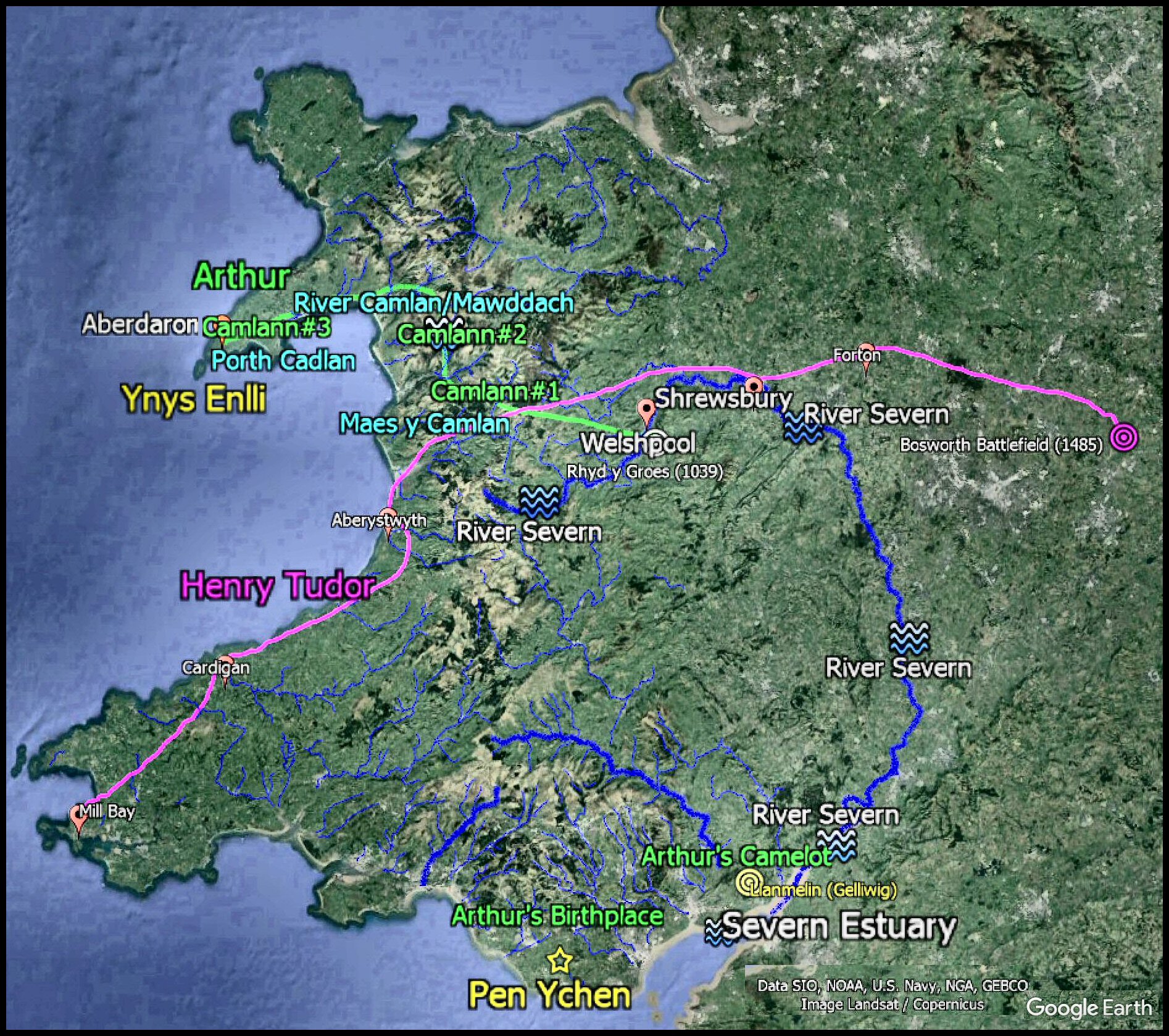
When Henry Tudor, having his descent from Welsh Kings, lands in Pembroke on the west coast of South Wales and marches through Central Wales to win the Battle of Bosworth to become King Henry VII of Britain, he would have passed the northern reach of the Severn River where the Battle of Camlann17.6 was fought. The River Severn then flows down the east side of Wales to the sea (which with the River Dee to the north, roughly outlines the country of Wales today) and, upon reaching the Severn Estuary in South Wales, it flows past the hillfort on the western shore that was once King Arthur's Camelot1.8 in Monmouth, next to Glamorgan (named after Morgan Hen, his descendant) with Arthur's birth-place in Pen Ychen2.2.--- Not England; not Tintagel, Cornwall; not Scotland; not France. 'Cymru yw'r Brenin Arthur'!; Wales is the true place of King Arthur!
The footnotes shown in red are essential to support the telling of this most truthful story of Arthur. Although shown in the hardcover book they are neither linked nor included to avoid the high costs of color printing in order to reduce the per-book cost. In this ebook the story and the references are shown. You will find the footnotes that relate to each chapter organized by chapter and number and after that: the fuller background references. The more universal footnotes are shown at the end with letters such as: (ASC) Anglo-Saxon Chronicle, (AC) Annales_Cambriae, (NEN) Nennius - Historia Brittonum, (GIL) Gildas-Ruin and Conquest of Britain, (GM) Geoffrey of Monmouth The History of the Kings of Britain (an imaginary mishmash to be avoided), (MAB) The_Mabinogion: (CO) Culhwch and Olwen, or The Twrch Trwyth, (DR) & The Dream of Rhonabwy & (LL) The Story of Lludd and Llevelys, (SG) Stanzas of the Grave, (TRI) Triads, (LBS) Lives of the British Saints, (BBC) - The Black Book of Carmarthen, and others.
References in published books are clumsy to use and usually remain unread. The big advantage to the references in this ebook is that they are clickable so that you can click directly to the reference and return back to your place. You will find in them the many details of my research that support the accuracy of this story of the true Arthur.
Everyone has an opinion on the true Arthur and the discussions and arguments will be here forever. To reveal the true Arthur is like saying that 'Peter Pan' is just a faun or satyr standing on his hindquarters with legs and horns of a goat, playing a flute. This would be disappointing. However, in this case, Arthur is not mythological, but a real person who was not only a King, but also a Saint, who needs to be judged on his true merits and faults. The footnoted references support this!
Dedicated to my wife (g) Wendy who shared the Arthur adventures with me and encouraged me to complete this book.
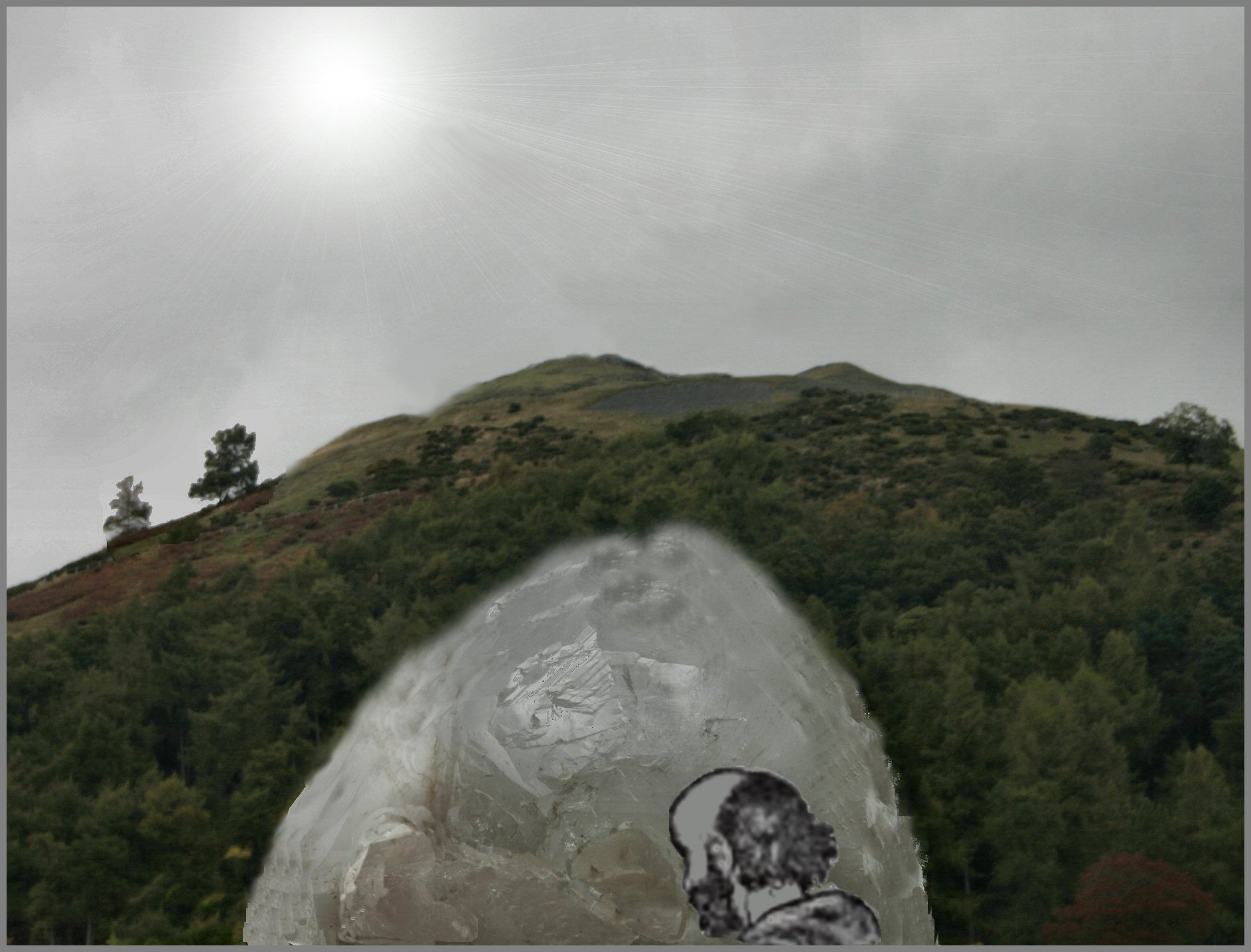
There was a cold misty rain coming in from the shore. It was almost a fog, but there was no mistaking the drops of rain that the wind was slamming into your face and slowly but steadily turning your clothes into a shapeless, dripping rag. It is like that almost every day on the Welsh coast, but today was not any ordinary day. It was the day that light would illuminate the Dark Ages of Britannia and unravel the myth of King Arthur.
A shadowy figure, seeming to be dressed as a monk, can be seen through the raindrops standing outside a rocky hillside covered by grass. Suddenly a crystal doorway appears in front of him. This hill is called Bryn Myrddin or as the English say 'Merlin's Hill', located near Carmarthen town in Wales.
His head is shaved, not in the circular fashion of the Benedictine monks, but shaved from ear to ear leaving the front bald, but curly hair in the back. He takes his wooden staff which has a spiral pattern around it and starts banging on the crystal door, while shouting, “Merlyn, wake up!” .... There is no answer.
He shouts again, “I know you are in there, Menw fab Teirgwaedd1.1, one of the three great enchanters of the Prydain TriadsTRI and the shapeshifter who assisted my victory against the Gewissei1.2 swine and Saxons at Badon.” ... Still no answer.
“I am not going to stop knocking until you answer.”
Finally, a voice comes from the other side of the crystal door, saying, “Leave me alone, I am sleeping.” His figure is barely visible on the other side.
The monk shouts, “Is that the proper manner to speak to your king?”
Merlyn grumbles, “What is that you say: king? You do not look much like a king to me! All I see out there is one of those annoying Celtic saints, bringing their Christian magic while building their churches and desecrating the sacred Druid groves. Have you come to gloat at my plight?”
The monk replies, “I am not any ordinary saint. I am known as Saint Arthmael or, to those in Brittany, as Saint Armel, but you would know me as Arthur.”

Merlyn shouts, “That is preposterous, I have never heard of Saints by that name in all of Wales. The King Arthur I knew was mortally wounded at Camlann and that was long ago. Morgana told me that he did not survive.”
The monk replies, “Since when do you believe my grandmother Morgana. She was always jealous of your skills. It was she who persuaded Nimue to trap you in this crystal cave because she felt that you were a bad influence on me. She tricked you because Arthur was not 'Arthur' anymore.”
Merlyn exclaims, “Are you denying the histories that say Arthur died in 537 at Camlaan17.2 at the age of 55?”
The monk replies, “As you can see I did survive my mortal wound, thanks to the Saints of Ynys Enlli1.3, now known as Bardsey. I left there to live out the rest of my life as a Saint in Brittany, living to age 801.4.”
Merlyn retorts, “I find this to be suspicious for I recall that the Saints have claimed that Jesus survived his crucifixion and likewise lived to be 80 years old1.5! Once I could have believed that magic could resurrect one from the dead, but I have lost all faith in magic. I cannot forgive my stupidity to be blinded by love, enticed, and tricked by my apprentice Nimue.”
Merlyn continues his regrets, “In my paralyzed state, trapped by my own magic, I was unable to perceive the evil plans of your cousin Mordred1.6 and to prevent him from seducing Queen Gwenhwyfar1.7. It was almost a relief to hear that Arthur's Court at Gelliwig1.8 was no more, for I would not have to face the truth that I had failed my King.”
The monk commiserates, “I do understand your grief, Merlyn, but no one could have predicted that Mordred and Gwenhwyfar's affair would result in the downfall of the kingdom. Mordred, pretending to give her the affection for which I was remiss in giving, was all that time plotting to be the new King beside her while enlisting the help of our enemies.”
Merlyn grunts in disgust, “Why are we talking about Arthur's kingdom? All kingdoms rise and fall and are forgotten. Since when do you monks care about earthly kingdoms. Aren't you supposed to be praying night and day for God's kingdom? How could an insignificant monk like you have any part in that Camelot myth or shed tears for poor Guinevere's unrequited love for her dearest Lancelot? If you have so much affection for star-crossed lovers, why don't you, just go, Friar Laurence, and collect some mistletoe for Romeo's Juliet to kiss and die.”
The monk smiles, “Becoming literate I see, my dear friend Merlyn. I thought your Druid ancestors mistrusted the written word. Sounds like you have been reading Shakespeare in your copious spare time.”
Merlyn, observing the dragon near his feet, “What is that dragon's head that is attached to your stole? Have you been murdering my dragons like those despicable armor-suited-princess-wooing knights?”
Arthur answers, “This dragon stole is part of my regalia1.9 that has replaced my ship, my mantle, my sword, my lance, my shield, my dagger, and, last but not least, my wife Gwenhwyfar. But I assure you that I am the true Arthur and even before the proof of Camelot was known in the poem, 'Arthur and the Eagle'1.10”
The monk recites from the poem:
'If thou wilt have unveiled discourse
Thou art the universe, by Necessity, by Destiny,
Until the other universe of no illusory luster occurs.'
Merlyn scoffs, “I am not to be fooled by your studied historical babble. The eagle in that poem is Mordred: a cousin, not a nephew. The regalia you claim to have owned sounds like a collection in a museum, not a stole but stolen. I suggest that you continue your prayers and 'Our Father's' and grow fatter with your charity. This eagle does not prove that Arthur existed.”
The monk laughs, “Sorry, I was just having fun with you because you are being so dense! Of course, it is hard for many to see the truth when their heads have been filled with academic lies, yet, you are a witness to the truth about King Arthur. After all, you were part of that famous fiction from the mind of Geoffrey of MonmouthGM that by plying your shapeshifting charm, you made it possible for Uther Pendragon1.11 to pretend to be King Gorlais to bed his wife Igraine and make me his son.”
Merlyn replies indifferently, “Yes, yes, I have heard the echoes of the serpent's breath:
Wherever that Merlin hack in the Boorman film 'Excalibur' found this Old Irish 'Charm of Making', he still mispronounced the word 'making' which does not end in 'vee' but 'ha'!”
The monk speaks excitedly, “Wait, wait, I have something amazing to tell you about this Arthur fabrication! I figured out that Geoffrey lifted this story about this non-existent Uther from the 'Life of St. Cadog'!LBS
I remembered that St. Cadog, my college friend, had told me that his father GwynllywGL, King Glywys' son, had kidnapped Gladys, the daughter of King Brychan and that St. Cadog was conceived from this violent union. Shortly after this, he did marry Gladys which would safeguard his belated sainthood as St. Woolos.”
The monk explains, “Geoffrey, misinterpreting Nennius'NEN words 'mab uther' as a genealogy, was unable to find one with Uther in it, so he used the story of St. Cadoc who is only two years younger than me and St. David's genealogy with no father shown. In an obvious anachronism, the church clerics, being always ready to disparage me, wrote that during this incident, that I, Arthur, stood on a hill with Kai9.2 and Bedwyr9.3 and allowed the chase to continue as Gwynllyw with Gladys on his horse sped by with the warriors of Brycheiniog in the chase.”
There is silence as Merlyn moves closer to the crystal wall, raising his eyebrows and contemplating the monk. Then he says, “Now this Gwynllyw explanation would seem far-fetched to most, but it does sound like Geoffrey's work. I could say that you have just made it up, but ... (he hesitates) ...
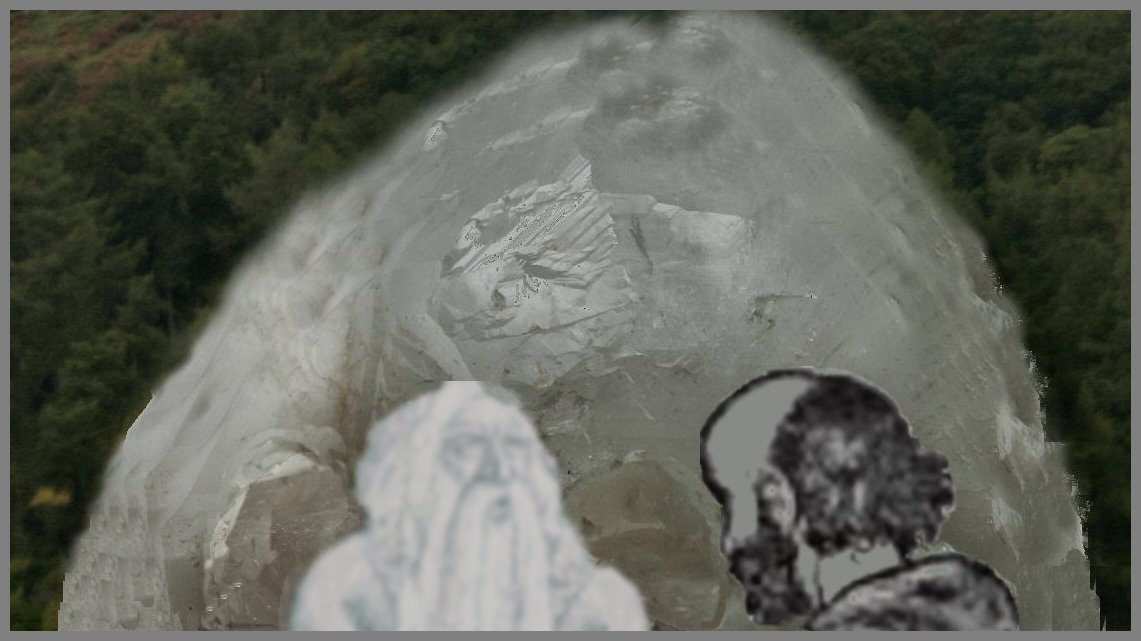
I have to admit that there is only one person on earth today who does not believe that Uther is Arthur's father and shapeshifted into Gorlais by Merlin, and that would be me, the real Merlyn, the greatest shapeshifter1.1 of all time! There are two Merlyns in history, is it possible that there are two Arthurs! No, you must be the real Arthur, but how are you still alive?”
With his brain now cleared of cobwebs and finally aware that the real Arthur is talking to him, Merlyn's blurred body behind the ice-like prison becomes animated, as he shouts, “My King, you must, with haste, ask the Lady of the Lake to give back your sword Caledfwlch2.5, and use it to break Ninue's spell to free me!”
Merlyn stops for a moment as he stares at the monk's attire, saying, “But first, you had better take off that absurd attire, as she despises all Christians.”
Merlyn continues loudly, “At last, we can drive those Angles and Saxons with their Hanoverian kings and queens back to Germany, under the true banner of the Welsh dragon with the conscience of Hywel Dda, the energy of Llywelyn the Great, and the force of Henry Tudor!”
Arthur, attempting to calm him down, “Merlyn, Merlyn, my dear friend, those days of swords and shields are long gone. Nowadays, countries use metal drones that rain destruction from the sky while holding a device that communicates to them with invisible waves, all from the safety of their underground cities. But, I have not come to incite the wars again. I have come to rouse you from your dreamtime because I need your help for a different quest. It is already two millennia since the Crucifixion of our Lord Jesus Christ near the Dead Sea.”

“Even Carmarthen town has come tumbling down according to your prophecy, with the oak tree having been displaced by a cement roadway1.12.”

Merlyn exclaims “Great Hermes! Have I been entombed all this time? Are you telling me that even the prophesied apocalyptic end of the world failed to free me from my crystal tomb!”
Arthur, smiling, says, “The Apocalypse is now zero for three, and the fourth is now awaited. With the Christians supporting the Jewish effort to clear the Temple Mount, it might be tomorrow, but enough of religious insanity. True magic is stronger than Revelation prophecies. Even more important than the end of the world or the fables about my predicted return, is the desperate need to end this banter and let me out of this OPPRESSIVE RAIN!”
Merlyn, becoming dejected says, “Alas, by the sound of it, I fear that even the once invincible Caledfwlch is now too rusted to break this spell.”
Arthur says triumphantly, “Ah, but I have come today with something more powerful than this ancient spell of Nimue. It is a dragon's tooth that my cousin, St. Paul Aurelianus5.6 pulled from the great dragon's mouth on the Isle of Batz in Brittany. As he intoned a prayer to the Creator, a sharp tooth had caught on his embroidered priestly stole while he leashed it and forced it into the sea.”
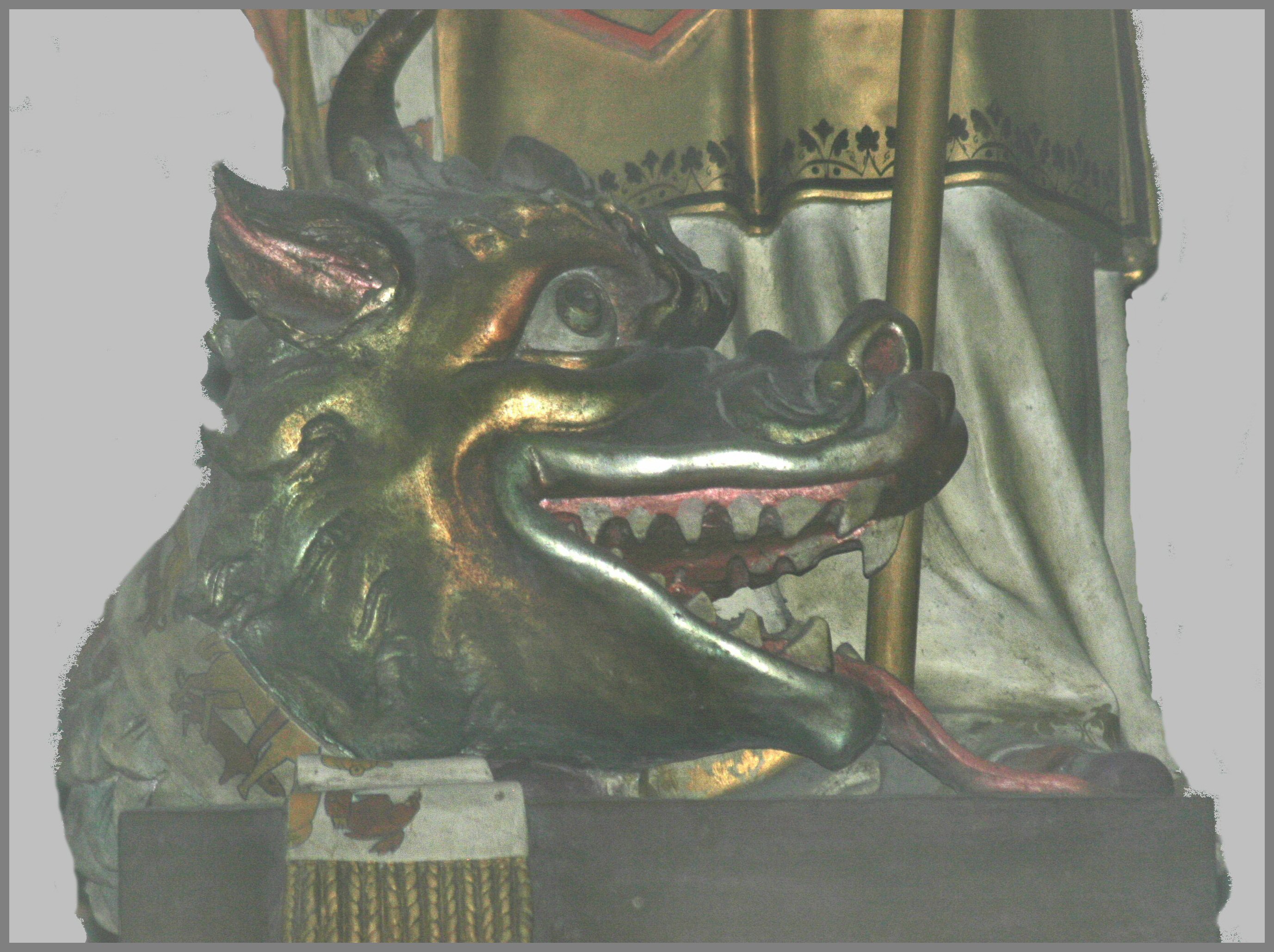
Merlyn, incredulously, replies “I doubt that those ubiquitous Church reenactments of St. Michael fighting the dragon or St. Patrick casting away the snakes can save me. Even the fanatical Christians, who misinterpret St. John's 'Revelation', can plainly see that these dragons are merely metaphors for evil kings. In my day before my entombment, I could command any dragon to breathe down fire upon my enemies with my raised staff and a spell, more powerful than any killer metal bird!”
Arthur replies confidently, “Yes, Merlyn, I have witnessed you doing just that! But I also have been graced by the power of early Christianity; for I, as a lowly monk, was able to expel a real dragon while the townspeople of my Church of St. Armel looked on in awe. In fact, it is at this Church that my coffin can be found, of which only my jawbone remains.”
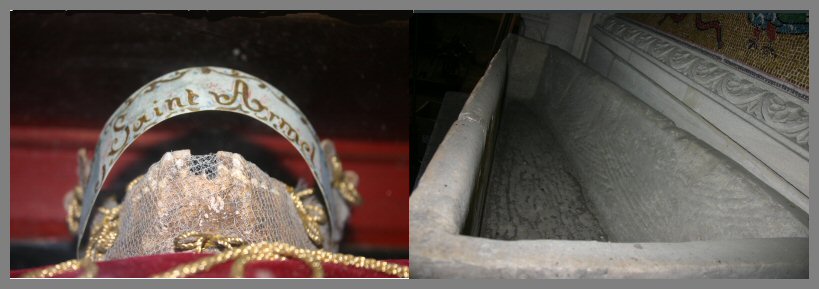
Merlyn says, “Make haste then, for perhaps the union of ancient magic and Christianity can create a stroke more powerful than Baal's1.15 thunderbolt and break the curse!”
Arthur, still in the persona of St. ArmelA5, crosses himself and says, “May the power of the dragon and the power of Jesus Christ, our Savior, the Lord of Hades having been resurrected, dissolve Ninue's magic.”
With the dragon's tooth, he draws the sign of the cross upon the crystal barrier. The crystal begins to crack outwardly from the mark of the cross. It begins to melt like ice, then turns into mist, and vanishes.
GENEALOGIES:
Appendix 6 - Genealogy of Arthur as descended from Constantine the Blessed, son of Magnus Maximus and his 2nd wife Elen



Appendix A6a - Genealogy of Arthur as descended from Magnus Maximus and Ceindrech (his first wife)

Appendix 7 - Genealogy connection to Emyr Lydaw (Budic, Emperor of Armorica (Brittany)) via his three sisters: Gwenonwy, Anna, and Afrella.

From Table VII The Lives of the British Saints, volume 1, by Baring-Gould, S. (Sabine), 1834-1924
Triad (93)
Three Men who specified their sufficiency from Arthur as their Gift:
Culhwch son of Cilydd son of Celyddon Wledig,
Huarwor son of Aflawn, and
Gordibla of Cornwall